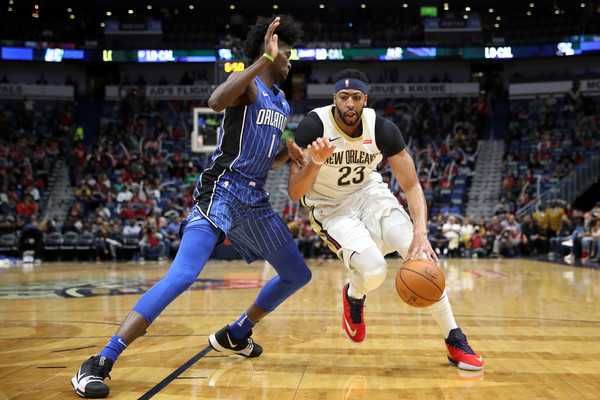Jonathan Isaac’s NBA journey began inauspiciously as the number six overall pick by the Orlando Magic. He was at risk of becoming yet another talented prospect drafted by a losing franchise whose career ends in disappointment. Two years later, a breakout season by Nikola Vucevic powered the Magic to a surprising playoff berth. It is now time to consider whether or not Jonathan Isaac can be part of the future for Orlando.

Photo courtesy of Josh Robbins via https://theathletic.com/924616/2019/04/15/jonathan-isaac-judah/
Isaac had an exceptional freshman season at Florida State before entering the draft. He averaged an impressive 12 points and 7.8 rebounds in only 26.6 minutes per game. He also recorded an outstanding shooting line of 50.8 field goal percentage, 34.8 three-point percentage, and 78.0 free throw percentage. Isaac even amassed more blocks than turnovers.
Rookie Season
Jonathan Isaac’s first season was uneven, as might be expected for a thin 19-year-old. He recorded a Position-Adjusted Offensive Efficiency below 28 percent. On the offensive boards, Isaac contributed only 37 percent of the expected value for his position. He got pushed around, and it showed. Isaac’s effective field goal percentage was 15% lower than we would expect based on the type of shots he took.
As a rookie, Isaac did show promise on the defensive end. The athletic prospect saved the Magic 28.6 points per 48 without including defensive rebounds, placing him in the 98th percentile of the league. Unfortunately, he had less impact on the defensive boards than we would expect given his size. Isaac generated 74.9 “Other Stops” (a term I use to encapsulate steals, blocks, charges drawn, and defensive loose ball recoveries). He also showed promise as a shot defender in year one. Isaac was 32 percent above position average in defending post-ups and 11 percent above position average in defending handoffs. As with most rookies, Isaac struggled in pick-and-roll coverage. He was below average defending the ballhandler (5.5% below average) and the screener (14.3% below average).
Improvement In Year Two
Entering his sophomore campaign with a lot to prove, Isaac responded in a big way. Increasing his offensive rebounding value helped Isaac produce 20.4 points per 48. This figure placed him in the 45th percentile of the league. Moving into the middle of the league was a drastic offensive improvement over his rookie year. By more than doubling his shooting efficiency from midrange, Isaac raised his True Shooting Percentage from 46.5 percent as a rookie to 53.7 percent last year.
On defense, Isaac led the Magic’s rotation players with 23.0 Points Saved per 48 Minutes. Despite playing far more minutes, Isaac still placed in the 85th percentile of the league per minute. In terms of total Points Saved, he ranked in the 91st percentile. Isaac recorded an impressive 210 Other Stops, and also led the team with 57.2 Uncategorized Opponent Turnovers. Playing as a defensive 4’s this season (rather than as a defensive 3) highlighted growth areas for Isaac on the defensive end. While he was above average for a 4 in defending spot-up jumpers, he fell below average against other play-types.
Isaac was much more effective covering the ballhandler on pick-and-rolls than covering the roll man (94.9% of position average to 74.8%). Once again, we see Isaac’s his quickness as an asset on the defensive end.. Isaac’s heavier workload brought his strengths and weaknesses into stark relief. His greatest weakness was in facing stronger opponents. Isaac was only able to force 86.1% of the average amount of misses from the post compared with other defensive 4’s.

Image courtesy of http://www.zimbio.com/photos/Jonathan+Isaac/Orlando+Magic+v+New+Orleans+Pelicans/OTlYYPywHBh
Putting it all together, Isaac was worth 4.2 wins last season. His production rate was just above league average at .101 wins per 48 minutes. Isaac operated at 48 percent Total Efficiency, a very respectable improvement from his 40% mark as a rookie but still slightly below average.
The Future?
Where might Jonathan Isaac go from here? His improved efficiency marks indicate that Isaac’s role suits him well. As he continues to progress, we can anticipate even more efficient performances from him in seasons to come. Moving forward, it is crystal clear that Isaac will often need to function as a defensive 4. Aaron Gordon is under contract long term, while Vucevic and Mo Bamba will take up the minutes at center. Khem Birch does not have enough offensive flexibility to play alongside another big man. Isaac needs to be able to hold up in the post at times while also switching effectively onto smaller ballhandlers. I see Isaac’s lateral quickness as a welcome and natural antidote for Aaron Gordon’s limitations as a defensive wing.
The best possible future for the Magic features Isaac and Gordon working in tandem. Gordon would carry more scoring and playmaking responsibility, while Isaac would function as a weakside shot-blocker and help defender. Isaac would chase quicker opponents for stretches, allowing Orlando to compensate for having bigger forwards.
To move forward, Isaac needs to continue to make gains with his jumper. On defense, he must make better reads in pick-and-roll coverage. If Orlando is going to establish themselves as a perennial playoff team, Jonathan Isaac’s continued development is key. If he cannot make strides, the Magic may find their ceiling much lower than they currently hope it will be. Is Jonathan Isaac the future for Orlando?






